|
|
We resole with various product type depending on the use of your footwear. As an example, work boots generally use a much heavier sole
than a cowboy western boot. Then we have to consider the different materials available for resoling:
Leather of various thicknesses defined by a thickness measurement based on ounces per square foot or by a thickness measurement called the "iron."
Example: a piece of 6 oz leather will be roughly 1/8 inch thick, or 4.5 iron or visually the thickness of 2 dimes stacked up. A piece of leather that is 16 oz will be roughly 1/4 inch thick and about the same thickness as 4 dimes stacked.
An Italian dress shoe many times utilizes an 8 iron whereas cowboy western boots use from 10/11 iron to perhaps as heavy as a 13 iron. Other mens dress shoes commonly use a 9 iron or even 10/11 iron based on the construction and service of the shoe.
We use a 11/12 iron. Many times the thickness measurement is given in a range (like 11/12) since the process doesn't allow exact to the mm tanning of hide and the fact that hides are not grown in a set and certain thickness, flawlessly.
Where on a cowhide does the sole come from? It comes from an area of the cowhide referred to as "the bend." The "bend" is a portion of the cowhide that runs on either side of the backbone.
Neoprene. Many ask what is that anyway?
According to Merriam-Webster
Main Entry: neo*prene
Function: noun
Etymology: ne- + chloroprene
Date: 1937
: a synthetic rubber made by the polymerization of chloroprene, characterized by superior resistance (as to oils), and used especially for special-purpose clothing (as gloves and wet suits).
We add to that "soles" and materials for resoling. Neoprene is very desirable when resoling some shoes, work boots and coboy western boots when they will be worn in an area where resistance to oil is needed.
Like leather and rubber soles including Vibram ® unit soles, the thickness measurement is spoken of in "iron" -- all shoe and boot repair shops use this terminology.
In addition to being oil resistant, flexible and resilient, a neoprene resole will outlast a leather resole worn under the same conditions. The usual color of a neoprene sole is black.
Rubber resoling material is often used when durability is a main concern over traditional look in a dress or casual shoe or boot.
Like leather and neoprene soles including Vibram ® unit soles, the thickness measurement for rubber soles is described as the "iron" -- all shoe and boot repair shops use this terminology.
Some rubber soles have higher degree of traction than others and always more traction than leather. A good OEM and replacement sole for food service and other applications where non-slip is a must, try the Vibram ® 1330 Newporter which is ideal for use in restaurant environments.
One should be careful when selecting a rubber resole for someone having trouble picking up their feet or subject to foot drag -- always consult your doctor when deciding which type resole to accomodate mobility concerns.
Rubber, like neopren will out last a leather sole subjected to the same conditions.
Crepe is an elastic material obtained from the latex sap of trees being vulcanized and finished into a variety of products with a great percentage of production going to shoe soles.
Crepe is very useful when comfort is the priority. Even cowboy western boots now have crepe soles. The demand for crepe material for resole of footwear continues to grow worlwide today.
Click here for genuine Vibram ® soles and specific use recommendations for oil, heat and slip resistance.
Please consider your shoe investment when considering a resole or repair. A typical mens dress shoe can be resoled many times, perhaps up to 10 times. We have customers with shoes or boots well over 25 years old. They keep them in good repair and cleaned and shined properly.
We ask that you frst decide the use of your footwear and then weigh the purpose and need against the effect on the environment: "...shoe repair is among the oldest forms of recycling. Each year, the shoe repair industry keeps some 62 million pairs of shoes out of landfills and on consumers' feet." - Shoe Service Institute of America
|
|

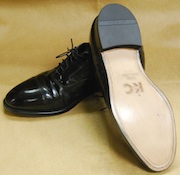
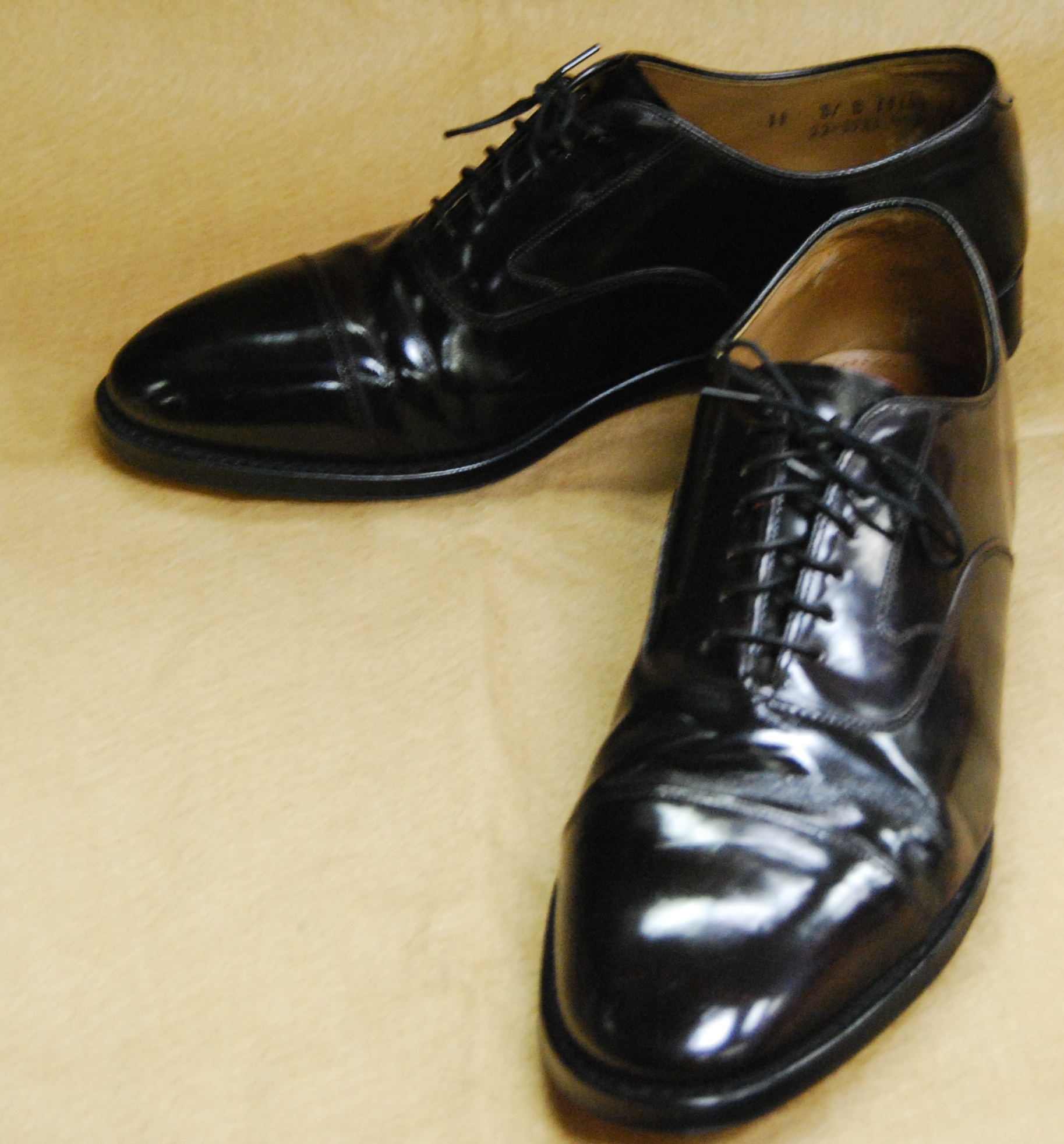 This pair of Johnston & Murphy mens cap toe dress shoe was resoled with a Prime Leather sole.
Additionally, because this customer chose "The Works" we added the "color touch up" to cover scuffs and dye wear.
Click on image above to see larger view.
This pair of Johnston & Murphy mens cap toe dress shoe was resoled with a Prime Leather sole.
Additionally, because this customer chose "The Works" we added the "color touch up" to cover scuffs and dye wear.
Click on image above to see larger view.
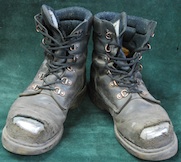
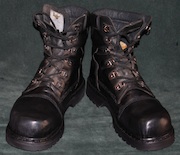 This pair of Dr. Martens work boots resoled with genuine Vibram ® 134AR unit sole.
Shop Made Leather Toe Cap over steel toe after layered leather patch.
Click on image above to see larger view.
This pair of Dr. Martens work boots resoled with genuine Vibram ® 134AR unit sole.
Shop Made Leather Toe Cap over steel toe after layered leather patch.
Click on image above to see larger view.
|

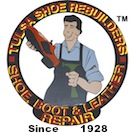



 This pair of Johnston & Murphy mens cap toe dress shoe was resoled with a Prime Leather sole.
Additionally, because this customer chose "The Works" we added the "color touch up" to cover scuffs and dye wear.
Click on image above to see larger view.
This pair of Johnston & Murphy mens cap toe dress shoe was resoled with a Prime Leather sole.
Additionally, because this customer chose "The Works" we added the "color touch up" to cover scuffs and dye wear.
Click on image above to see larger view.
 This pair of Dr. Martens work boots resoled with genuine Vibram ® 134AR unit sole.
Shop Made Leather Toe Cap over steel toe after layered leather patch.
Click on image above to see larger view.
This pair of Dr. Martens work boots resoled with genuine Vibram ® 134AR unit sole.
Shop Made Leather Toe Cap over steel toe after layered leather patch.
Click on image above to see larger view.